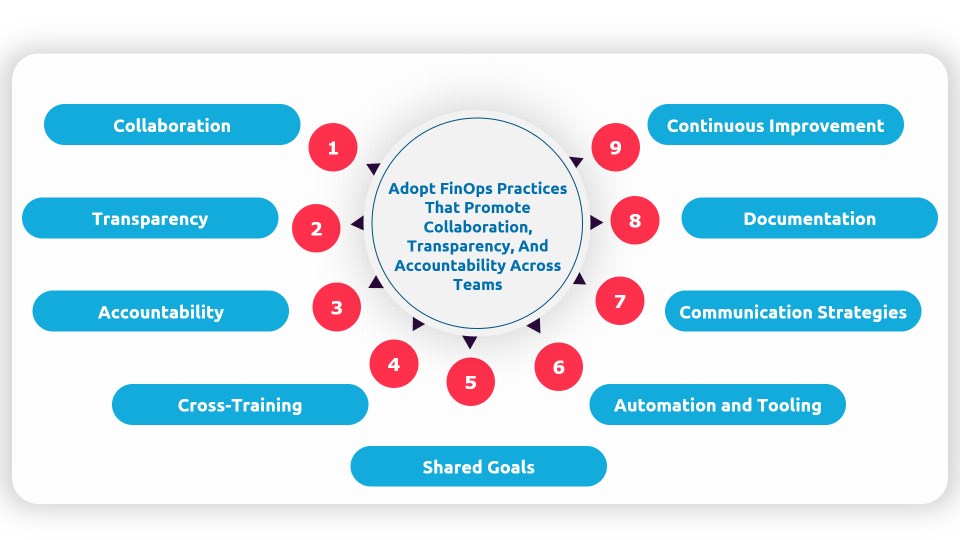Adopting FinOps practices that encourage collaboration, transparency, and accountability among teams is vital for effective cloud cost management. FinOps, short for Financial Operations, integrates finance, operations, and engineering teams to optimize cloud spending. Here’s a detailed breakdown on achieving these objectives:
- Collaboration:
- Foster collaboration among traditionally siloed teams, like finance, operations, and development.
- Actions:
- Cross-Functional Teams: Form teams comprising members from finance, operations, and development to collectively tackle cost management challenges.
- Regular Meetings: Schedule periodic meetings or workshops for discussing budget goals, spending patterns, and optimization strategies.
- Transparency:
- Ensure all stakeholders have clear visibility into cloud spending and comprehend how their actions impact costs.
- Actions:
- Cost Dashboards: Implement real-time cost dashboards to monitor expenses at various levels of granularity.
- Cost Allocation: Use transparent cost allocation practices, like proper tagging, to accurately attribute costs to projects or teams.
- Communication Channels: Establish open communication channels for sharing insights and best practices related to cloud cost management.
- Accountability:
- Promote accountability by assigning teams responsibility for managing and optimizing their cloud costs.
- Actions:
- Budget Ownership: Allocate budget ownership to specific teams, holding them accountable for staying within allocated budgets.
- Performance Metrics: Define and monitor KPIs related to cost efficiency, ensuring teams meet these metrics.
- Cost Impact Training: Train teams on how their actions directly affect costs, fostering ownership and responsibility.
- Cross-Training:
- Facilitate cross-training between finance, operations, and development teams for better understanding of respective roles and challenges.
- Actions:
- Workshops and Training Programs: Conduct sessions to elucidate the financial implications of technical decisions.
- Rotation Programs: Implement cross-functional rotation programs for a holistic view of the organization’s operations.
- Shared Goals:
- Align financial and operational goals to establish a common understanding of overall organizational objectives.
- Actions:
- Goal Alignment Workshops: Organize workshops to align financial goals like cost savings with operational goals.
- Incentives: Introduce reward programs for achieving cost-efficiency targets while maintaining operational performance.
- Automation and Tooling:
- Implement tools promoting collaboration, transparency, and accountability.
- Actions:
- Collaborative Platforms: Utilize tools allowing teams to share information, insights, and updates on cloud costs.
- Automated Alerts: Set up alerts notifying teams nearing or exceeding budget limits, facilitating proactive cost management.
- Communication Strategies:
- Develop clear communication strategies to disseminate financial insights and goals.
- Actions:
- Regular Updates: Provide updates on cloud spending and budget performance during meetings or through channels.
- Feedback Mechanisms: Establish avenues for teams to offer input on cost management strategies.
- Documentation:
- Document FinOps processes, best practices, and guidelines for shared understanding.
- Actions:
- Knowledge Repositories: Create repositories housing documentation on FinOps practices for easy access.
- Continuous Improvement:
- Encourage continuous improvement by reviewing and refining FinOps practices regularly.
- Actions:
- Post-Implementation Reviews: Review cost optimization initiatives to identify lessons learned and areas for improvement.
- Feedback Loops: Create loops for teams to suggest enhancements to FinOps practices.
By adopting these FinOps practices, organizations break down silos, improve communication, and create a culture of shared responsibility for cloud cost management. This collaborative and transparent approach enhances spending optimization while meeting business objectives. It nurtures an understanding of the financial implications of technical decisions and fosters a culture of responsibility and improvement.
Refer to the Part 1 FinOps – Budget Management and Forecasting Processes, Challenges, and Solutions and Part 2 – Identify and Set Clear Budget Goals based on Business Requirements and Priorities and Part-3: Implementing Automated Tools and Scripts to Manage Cloud Budgets

 English | EN
English | EN 

